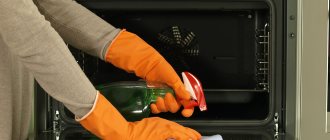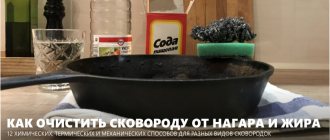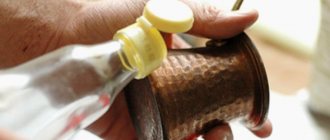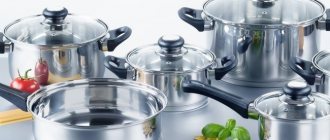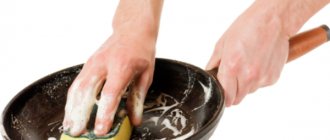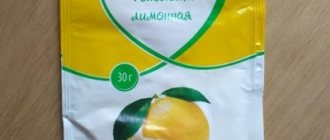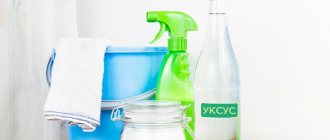The task of a kitchen hood is to remove fumes, unpleasant odors, smoke and fumes that arise during the cooking process. Thanks to the ventilation function, the air in the room is regularly updated, providing a favorable microclimate.
Over time, the filtering ventilation grilles of the hood become covered with grease and cease to cope with their tasks. Find out how to properly and effectively clean grease from hood grates here.
Why and how often should you wash?
The air in the kitchen constantly contains not only ordinary dust, but also particles of fat that rise from a boiling pot or squealing frying pan along with steam. Passing through the grate of the hood, the fat settles inside it and accumulates layer by layer.
You can deal with external dirt quickly - simply wipe it off without allowing it to dry out.
If you do not clean the internal parts (metal grease filter, fan) from grease and dirt, the equipment will simply stop performing its function.
Partial disassembly is done once every month or two to remove and clean the hood filter. General cleaning is carried out annually, and sometimes more often if there is extraneous noise or other operational disturbances.
There is an opinion that a powerful engine will cope better with exhaust air removal. Increasing the hood leads to the overturning of the draft. In apartment buildings, such phenomena as aromas from someone else's kitchen, tobacco smoke from a neighbor behind the wall indicate the presence of a supermotor in you or him.
No amount of washing will remove the smell from the hood if it circulates back from the air duct. To quickly solve the problem, simply open a window or vent to change the direction of air movement.
Types of ventilation
The ventilation system in the kitchen can be:
- natural, that is, providing for the entry of fresh air into the room and the outflow of internal air due to the creation of special pressure;
- supply air, which assumes that stale air is pushed out of the room by a stream of fresh oxygen;
- exhaust, the work of which is to pull out old air from the room and the influx of new air masses due to pressure release;
- supply and exhaust, anticipating the movement of air and exchange processes thanks to the installation of a special apparatus.
In most apartment buildings and private buildings, ventilation is done naturally. Such a system is considered simple, as it allows the exhaust air to be replaced through windows and doors. In this case, a hole with a grill, through which gas that is no longer suitable for breathing escapes from the room, is always placed in the upper part of the wall.
Both fresh and exhaust air circulate through the channels
How to disassemble a hood: preparation stages
The basic design of any hood (Krona, Bosch, Hansa, Elicor) consists of a motor, a fan, a filter or two, and lighting. The entire system in the housing is assembled with a control infrastructure of varying degrees of complexity.
Before proceeding with disassembly, the equipment is de-energized!
How to remove the filter:
The instruction manual may contain disassembly instructions. First of all, read the recommendations.
- Make room for work.
- Most grease traps are removed by pressing the fasteners to the sides, after which the frame falls out or is pulled out of the grooves. Sometimes the grille is located behind a decorative strip secured with self-tapping screws.
How to open the hood to clean it completely:
- Remove the plug from the socket.
- Remove the wall mountings and unfasten the built-in hood from the cabinet shelf.
- Unscrew the screws in sequence on the common cover, the fan cover, and the fan mounting to the engine.
- Disconnect the motor and cables from the housing.
- Remove the ventilation pipe.
Typical causes of device malfunctions
To understand the causes of possible malfunctions with the hood, you need to know the principle of operation of the device. It is based on two-stroke indoor air purification:
- All large molecular particles of the intake air volume are cleaned.
- Filters all macro- and microelements of incoming oxygen.
The further cleaning process depends on the type of device design (combined, circulation, evacuating) and filtration elements.
What malfunctions may occur:
- There is a problem with ventilation in the apartment - before installing the hood, you need to check the draft of the exhaust duct. If it becomes clogged, then all the circulated air, filled with unpleasant odors, will return back to the apartment or to the neighbors, and condensation will settle on the windows. Checking the draft force is very simple: you need to bring a lit lighter to the ventilation grille. If the flame deviates towards the air flow, this means that everything is in order with ventilation;
- contamination of the grease trap or filter in the hood - instructions for carrying out preventive work against contamination of the filters or for cleaning the grease traps yourself are included with the hood;
Dirty and clean filter
Switch board and button replacement
Also, the reasons for poor operation of the device may be a breakdown of the electronic interface, a malfunction of the exhaust fan, poor contact in the plug or socket, or loose terminals in the hood body.
In order to protect the device from power surges, it is worth purchasing a special voltage relay
Repairing a hood with your own hands is not difficult. It is enough to carefully study the mechanism of operation of the device, and the troubleshooting process will not be difficult.
Cleaning with folk remedies
The improvised remedies, also called folk remedies, are not so harmless to the skin of your hands - so you should wear rubber gloves. Protect your eyes from caustic liquids with a pungent odor - vinegar, ammonia. Keep the window open while working. During the chemical reaction, the treated grating can be placed in a plastic bag.
For the grease-absorbing filter, select flat dishes in size so that it is completely immersed in the cleaning composition. For example, a baby plastic bathtub, a flat tray, or a baking sheet for baking in the oven will do.
Ammonia
Dissolve 2 tablespoons of ammonia in 4 liters of warm water and soak the hood parts for an hour. When the surfaces are clean, finish washing by rinsing in clean water.
Soda
You will need a suitable container, hot water and a pack of baking soda.
To clean a steel or aluminum hood filter with soda:
- heat 5 liters of water to a boil and pour in a glass of cleaning product, adding gradually with a spoon;
- place the mesh in boiling water and leave for 10 minutes;
- after soaking, the fat is washed off under running warm water, removing remaining deposits with a brush;
- The mesh is wiped and left until completely dry.
Vinegar
An effective remedy is obtained from a solution of concentrated acetic acid in water in a ratio of 1:7. The surface is treated with a sponge generously moistened with the composition. After 10 minutes, wash off with plenty of warm water.
Citric acid
You can use acid in powder, having previously dissolved it in water, or take a lemon, cut it in half and rub it on the contaminated areas. As it is absorbed, the juice will dissolve the fat. Heavily greasy areas are wiped with lemon juice several times until completely clean.
Laundry soap
The soap is grated and soaked in hot water. When the shavings dissolve, a mesh is placed there. The cooling water is heated, then it will be possible to wash off the fat faster. When the dirt gets wet, all that remains is to rinse, dry and put the mesh in place.
Combined means
To be sure, dirt removers are combined.
The dry method of cleaning with soda and vinegar is faster, without boiling:
- powder is evenly scattered onto a grid laid on a flat surface;
- For convenience, acetic acid 70% is poured into a spray bottle and carefully, without lifting it high, sprinkled over the layer of soda;
- leave to interact for 20–30 minutes;
- washed with plenty of water and dried.
Another good remedy that will allow you to wash a greasy hood with improvised means:
- add half a glass of liquid soap, 2 tbsp. to a large container with 5-6 liters of hot water. dry citric acid and half a glass of baking soda;
- soak the filter, preferably entirely;
- after 3–4 hours, the mesh is washed with a brush, removing any remaining dirt.
Mustard powder
The powder is mixed with water in such a proportion to obtain a semi-liquid slurry. The grate is placed on a tray, rubbed and covered with film to prevent the mixture from drying out. After 15–20 minutes, wash in water using a sponge or brush.
Whiteness
Whiteness copes with dirt, but is somewhat worse than soda. In addition, the smell fills the entire room even after washing with detergents. If you decide to soak the grate with white, wear safety glasses.
Saline solution
Table salt is dissolved in hot water. To obtain the required concentration, 200 g of salt per 5-6 liters will be enough. Softening of old fat occurs actively only at high temperatures, so the container is heated or boiling water is added.
Use of chemicals
Using store-bought detergents greatly simplifies the task and speeds up cleaning. However, some drugs should be used with extreme caution - active reagents can harm human health and damage equipment.
Overview of household cleaning products
Store-bought dishwasher and stove cleaners work well to remove grease from the hood.
Among the variety of household chemicals, the following drugs have proven themselves well:
- Spray “1 minute”, Sanita (Russia);
- Spray "Anti-Fat", Cinderella (Russia);
- Gel “Synergetic” (Germany);
- Spray and gel “Anti-Fat + Radiance”, Cilit Bang (Poland);
- Gel and spray “Shumanit”, Baghi (Israel).
Spray Sanita
A fast-acting product with active ingredients “corrodes” fat accumulations, plaque and other types of dirt in a matter of minutes. Express spray is considered one of the leaders due to its versatility and affordable cost.
Sanita spray is not intended for cleaning varnished, enameled, aluminum and painted surfaces.
Area of use: caring for kitchen equipment, furniture, blinds, plastic panels, tiles and dishes. The approximate cost of the bottle is 2.5 USD.
Cinderella "Anti-Fat"
An affordable, effective product that gently cleanses stubborn stains. Suitable for use on different types of surfaces after test use on a small area.
Before use, the sprayer valve must be turned to the “open” position and the surface should be sprayed. After 20-25 minutes, remove dirt with a brush.
Price for 500 ml – 2-2.4 USD Among the disadvantages, users note a very liquid consistency and rapid consumption.
The main active ingredient of the Anti-Fat spray is soda. The natural cleaner does not act as quickly as chemical reagents, but the substance is safe
Synergetic for slabs
The gel-like product is positioned as a safe, natural preparation for cleaning stoves, ovens, frying pans and baking trays. It contains no harsh chemicals and is 100% biodegradable.
Limitations of use: surfaces made of brass, copper and copper alloys, as well as aluminum. Despite the safety, you should use gloves when working - they will protect your hands from drying out. Average cost – 10 USD/1 liter.
Range of action: soot, carbon deposits, grease, oil stains, scale and rust. Excellent for cleaning air intake grilles
Household chemicals Cilit Bang
Gels and spray “Anti-Fat + Shine” are a Polish development for removing burnt and greasy stains in the kitchen. Grease removers are made on the basis of surfactants, due to which they have a “soft” effect on dirt. There are no abrasives in the composition.
The drug is easy to use, spreads well on the surface and is optimal for timely care. The cost of “Anti-Fat + Radiance” is 6 USD/750 ml.
In practice, Anti-Fat + Shine has shown its effectiveness in the fight against “fresh” drops of fat and soot stains. The product is almost powerless against limescale, hard deposits, and old rust.
"Shumanit" from Baga
Professional chemistry for easy removal of fat from surfaces involved in food preparation. “Shumanit” is a potent remedy, and therefore requires strict safety measures during use.
Distinctive features:
- no abrasive additives;
- antibacterial effect;
- fast action - the first effect is noticeable 5 minutes after applying the drug;
- effective cleansing of old fat accumulations;
- economical consumption.
The product is not suitable for cleaning aluminum or painted surfaces. Cost – 4.5 USD/500 ml.
“Shumanite” is toxic and has a specific pungent odor. Work must be carried out wearing a gauze bandage or a respirator. A prerequisite is sufficient ventilation
Technology for using store-bought fat solvents
Most of the products offered have similar tactics for cleaning the hood from grease; a possible difference is the time of “soaking” in the chemical preparation.
Standard plan of action:
- Place the air intake grille on an oven tray or place it in a large container.
- Carefully treat the parts with the selected preparation.
- Leave the fat solvent - the permissible exposure time is written on the packaging or in the instructions for the product.
- In case of strong accumulations of dirt, the filters should be washed with warm water - this procedure will wash away the separated fatty layers.
To remove any remaining deposits, the grille must be re-treated with a cleaning agent.
After cleaning, the hood parts must be washed thoroughly. There should be no chemical components left on the surface - substances can impede the operation of the hood or get into the food on the stove
Heavy artillery: the risks of a radical method
When all gentle methods have been tried and are unsuccessful, some resort to “aggressive” treatment. An arsenal for cleaning drain pipes such as “ Mole ”, “ Tiret ”, “ Steril ”, “ Pipe ”, etc.
Before deciding to take a radical step, it is worth assessing the possible risks and taking into account all the nuances of performing the work:
- failure to follow the instructions for preparing the solution and the holding time of the reagent can result in deformation of metal parts;
- the maximum permissible number of radical cleanings is 1-2 times during the entire period of operation;
- The method is advisable to use in the most “neglected” situations, when hard deposits have clogged all the cells of the air intake grille.
They begin work after studying the instructions and following safety standards.
You need to prepare an iron baking sheet or tray in advance. The manipulation scheme depends on the form of the product: liquid concentrate, granules or powder
Possible course of work:
- Liquid product . Place the parts to be treated in a container and fill with a solution prepared according to the manufacturer’s instructions - the reaction will begin instantly. After a couple of minutes, remove the grate and rinse with water several times.
- Granular component . Place contaminated items on a tray, sprinkle with cleaning powder, and pour hot water over them. After breaking down the fat, wash the air distributor thoroughly.
Carefully pour the used caustic solution into the toilet.
How to clean with a steam generator
The steam generator will help clean the hood from grease without chemicals and without streaks. The equipment is equipped with convenient attachments that will allow you to penetrate into the most inaccessible corners. You can clean the inside of the hood without removing it from the wall.
With the help of steam, old fatty deposits are easily softened with a directed jet for 10–20 s, after which they are removed with a dry cloth. Garbage and dust are first removed with a vacuum cleaner so that they do not fly away under steam pressure throughout the kitchen.
Working with a steam generator requires certain skills. If handled carelessly, you can get burned by the steam.
Preparatory activities
Before cleaning the hood, you must arm yourself with the factory instructions for the device and familiarize yourself with the manufacturer’s recommendations for care and operation. The paper should indicate how often to clean the hood and what cleaning products are suitable for cleaning.
Important! The products are selected depending on the material from which the body and parts are made - some chemicals can damage the coating.
Treatment is carried out only after the device is completely de-energized. Therefore, you will have to figure out how the hood turns off - otherwise, if liquid gets inside the housing, you risk getting a short circuit and electric shock.
Does your kitchen have a hood?
Not really
Useful information: you can find out how to clean your hood from grease here. Also read how to clean the hood filter from grease.
Prepare the preparations and tools you will need for cleaning:
- personal protective equipment – gloves, respirator (if necessary);
- a spacious container for soaking removable parts;
- kitchen sponge - one or more;
- a cloth or cloth for wet cleaning;
- cleaning products depending on the chosen processing method.
Washing with store-bought cleaning products
Specialized products such as “Shine Anti-grease”, “Shumanit” or “Azelite” do an excellent job of cleaning the filter. They completely eliminate stubborn fat and are packaged in containers with a dispenser. They are easy to use. The composition is applied to the grill and left for 10–15 minutes, after which it is thoroughly washed off.
Oven Cleaner is great for removing old grease from plastic parts.
Among the ingredients of cleaning products there are alkalis, so the effect of the composition is first tested on a small area.
If the hood has not been sanitized for many months, you can use radical fat solvents, for example, clean it with “Mole” or another product that removes fat and impurities that are difficult to dissolve in water:
- The grate is placed on a tray and the product is poured so that it covers it.
- A lot of foam will appear.
- Once the foaming stops, the dirt can be washed off.
The technical means contain alkalis or acids in a decent percentage, so they must be used according to their intended purpose. Such active reagents should not come into contact with kitchen work surfaces.
Steam cleaning
Using a steam generator, cleaning a fume hood is quite simple and convenient. This is a special device that allows you to treat almost any hard-to-reach surfaces, including ventilation grilles, with a steam flow at a temperature of 150 degrees Celsius and above.
It is capable of cleaning not only the internal filter elements, but also absolutely all existing elements of the hood. Use a nozzle with a tapered brush and fill the steam generator container with water. Separately, you should place a container with a diluted soap solution, in which you need to moisten the nozzle from time to time. After this, begin cleaning the device, carefully treating all places where sediment has formed. A steam cleaner not only allows you to thoroughly clean the kitchen hood grate, but also disinfects its surface.
My details
We have already figured out how to remove the hood grille and disassemble it completely yourself. Some nuances remain.
Grease filter
Filters are divided into disposable and reusable. In inexpensive models, volumetric liners made of acrylic or other synthetic material are simply changed every 2-3 months. Their pores quickly become clogged with oily impurities.
In recirculating hoods, an additional filter is installed that purifies the air with activated carbon. Can the carbon filter be washed? It is possible, like acrylic, but after that it will be useless.
Reusable grilles consist of a frame and a flat or three-dimensional mesh. They are made of metal. After washing and drying, they continue to serve and are effective until the hood becomes unusable. The main thing that allows dirt to settle on the mesh is the holes, so they must be clean.
Ventilation grill
The most basic way to clean grease from ventilation is with a steam generator. If equipment is not available, the ventilation grille is well soaked with soda and soap or washed with an anti-grease chemical.
Fan
It is quite difficult to wash the fan impeller by hand. It is soaked in alkali or acid.
Motor
The hood motor can only be cleaned using a dry method. After removing kitchen grease and dust from the surface with a napkin soaked in alcohol, its moving part is lubricated with grease or machine oil. If you do not clean the hood motor, its internal cavities and the rotor from plaque, it will overheat and may fail.
Frame
After disassembling, wash the body with soapy water. Despite the simplicity of the work, there is no need to rush. The edges of the metal are quite sharp, it is easy to get hurt.
Inner walls
To clean the inside of your home hood, you will need to apply some kind of product, for example, the one used to clean kitchen surfaces. Then the surface is washed with plenty of water.
Buttons
The buttons are washed so that they do not stick after pressing. Soda gruel, applied on all sides and rubbed with an old toothbrush, removes fatty deposits well.
Duct and pipes
Pipes usually do not require cleaning. The main deposits remain on the hood parts. If you want absolute cleanliness or the air duct is in a disrepair, everything that can be disassembled can be removed and washed with any anti-grease agent. In extreme cases, the pipes can be changed. Plastic, like corrugation, is inexpensive.
Checking the functionality of the ventilation duct
Before cleaning the ventilation shaft, you must first make sure that the operation of the air ducts is really impaired. To do this, you can use a burning match - bring it to the grate and see if the flame deviates to the side. If this does not happen, then the ventilation system is not functioning well.
Using a lighter near a ventilation vent may cause undesirable consequences.
Utility workers do not recommend assessing the performance of ventilation systems in this way, as it is dangerous. The fact is that in buildings with main gas pipelines, gas leaks occur that get into the air duct. If you bring a flame to a ventilation shaft where the gas has not yet escaped, an explosion may occur. Gas workers advise resorting to a safe way to check the operation of ventilation:
- cut a piece of paper 30 cm long and 3 cm wide from a newspaper;
- bring the paper strip to the ventilation shaft grille, closing the windows and doors in the room;
- pay attention to whether a piece of paper is pulling towards the grid.
If the strip pulls, then there is no need to doubt the functionality of the ventilation. If the air duct does not respond properly, you should start cleaning the ventilation system.
Checking the functionality of the ventilation duct can be carried out in three stages
Features of cleaning hoods made of different materials
It is much easier to clean a metal hood than a plastic or tempered glass one.
Stainless steel
You can remove grease from stainless steel quickly and easily using any available means. The material will withstand boiling and strong chemicals. The maximum that can happen is that the surface will darken.
It is not recommended to clean stainless steel with abrasive powders and metal brushes. The appearance of the metal will suffer, scratches will appear, from which dirt will be more difficult to remove during subsequent washing.
Made of aluminum
An aluminum hood can be washed with soda, laundry soap, table salt, and mustard. Acids actively oxidize the metal, causing dark spots to appear on the grate. Alkali dissolves aluminum and renders the mesh unusable.
In the dishwasher, the filter is washed separately from the dishes at temperatures up to 65 degrees. Dishwasher tablets are not used.
Made of plastic
Plastic can be soaked and washed in the dishwasher at low temperature, but cannot be boiled or scraped with metal objects. Plastic is resistant to chemical compounds. The steam generator is used only for heat-resistant plastics.
Glass
Glass parts require careful handling. It is better not to rub them with powders, but to use liquids, pastes and gels. Apply the detergent composition with a sponge or soft brush. Provided daily cleaning, you can get by with a glass cleaning spray.
conclusions
When choosing a decorative grille for the kitchen, you should think about how the cleaning process will be carried out.
First of all, you need to pay attention to the design of the product. The accessory should be easy to remove and install in its place. We recommend choosing grilles with a rear flange and hidden fasteners or designs that are mounted using magnets.
Products should be cleaned with a damp cloth and non-aggressive detergents. Do not use hard brushes or sponges; you can easily damage the surface of the accessory.
Source: www.decogrille.ru
Proper care: life hacks for housewives
- Do not leave the hood running when it is not necessary. The air flow dries out the surfaces, and dirty sediment sticks tightly.
- Assemble the hood parts only when they are completely dry. The washing effect will last much longer.
- Do not turn on the stove burners idle, and especially when the fan is on. Plastic parts can be deformed by passing hot air.
- By cleaning the hood over the gas stove in a timely manner, you will not only avoid spontaneous combustion of accumulated deposits of fat and soot, but also increase the service life of the engine.
- Lemon not only cleanses greasy deposits, but also deodorizes the surface.
Cleaning the hood in an apartment or house really extends the life of household appliances. You just need to include it in the list of mandatory places for regular cleaning, along with the stove and kitchen apron. The equipment is designed in such a way that maintenance is simple. Each housewife will decide for herself what is the best way to wash off the fat.
Did you like the article? Tell your friends about it:
1 1
Useful tips
- When cleaning the non-removable parts of the hood, cover the surfaces underneath with film.
- Regularly wipe accessible parts of the hood to prevent large deposits of grease.
- Vinegar, citric acid, dishwashing detergent and laundry soap are suitable for cleaning stainless steel coatings.
- Carry out preventive cleaning with dismantling of the structure at least once every two months.
- A steam generator will help remove plaque without using chemicals.
Advice! To prevent the formation of a hard layer of fat on the hood body, minimize idle operation of the stove.
Keep your device clean - and it will delight you with long-term and trouble-free operation.
Air duct
Housewives with flow-type hoods may occasionally experience a decrease in the draft of the device. This indicates that the air duct is clogged. In this case, it and the ventilation grille must be cleaned. If the pipeline is smooth, this will not be difficult. A smooth round or rectangular channel can be easily disassembled, washed and reinstalled. With corrugated pipes everything is much more difficult. In some cases, it is easier to simply replace them with new ones than to clean them, especially if a lot of fatty deposits have formed in them.

